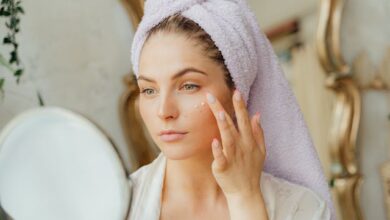How air pollution and skin aging are more connected than you think!

Air pollution and skin aging: you’ve heard of it, but it’s not that big of a deal, right?
Unfortunately, the more research we have on this connection, the more concerning it is.
Whether you live in a bustling city or a suburb, exposure to pollutants such as particulate matter can significantly accelerate the aging process of your skin.
We dive into the science of this connection and show you how to ensure your skin stays protected from harmful elements in the air.
Air pollution and skin aging: what is particulate matter?
Air pollution is a complex mix of gases, chemicals and particulate matter, including heavy metals, polycyclic aromatic hydrocarbons (PAHs), ozone and nitrogen dioxide. Particular particulate matter (PM) in particular has been identified as a major cause of skin damage.
Imagine millions of tiny particles of solid or liquid matter floating in the air. These particles typically come from three main sources:
- Combustion processes: Vehicles, power stations and home heating can all emit particulate matter from the combustion of fossil fuels (petrol, diesel, coal and wood).
- Industrial processes: Manufacturing, construction, mining and agricultural activities can generate particulate matter through processes such as grinding, crushing and material handling.
- Natural sources: Dust and soil particles, sea salt aerosols, pollen and volcanic ash are examples of natural sources of particulate matter.
Particulate matter comes in different sizes:
- PM10: These are particles with a diameter of 10 micrometers or smaller. They are inhalable and can enter the respiratory system and reach the lungs.
- 5: These are particles with a diameter of 2.5 micrometers or smaller. They can penetrate deeper into the lungs and even enter the bloodstream.
- Ultrafine particles: These have a diameter of less than 0.1 micrometers and can penetrate deep into the body.
Frequent inhalation of particulate matter can lead to respiratory problems such as asthma, bronchitis and reduced lung function. Exposure to fine particles can contribute to cardiovascular diseases such as heart attacks and strokes.
It is these smaller particles that can also damage the skin.
Air pollution and skin aging: how particulate matter causes damage
Fine dust of 2.5 micrometers or smaller can penetrate the outer layer of the skin. Once there, it can cause oxidative stress by generating free radicals. These highly reactive molecules cause damage to the cells in the skin, including the lipids, proteins and DNA.
Oxidative stress also causes inflammation in the skin, which can lead to problems such as acne, while conditions such as eczema and psoriasis can worsen.
The presence of pollutants in the skin can also increase the activity of matrix metalloproteinases (MMPs). These are enzymes that break down collagen and elastin in the skin. Increased MMP activity leads to the breakdown of these important proteins, causing the skin to lose elasticity and firmness.
Over time, repeated exposure to air pollution accelerates the formation of fine lines and wrinkles, age spots and other forms of hyperpigmentation, and sagging.
Air pollution and skin aging: what the research shows
Several studies have provided compelling evidence of how air pollution contributes to premature skin aging:
Air traffic pollution and skin aging: Research on 400 women aged 70 to 80 found that exposure to air pollution was significantly linked to signs of aging, particularly age spots. An increase in soot and particles from traffic was associated with 20 percent more age spots on the forehead and cheeks.
How Pollution Damages Skin: Researchers examined several studies and summarized the existing evidence that air pollution damages the skin through oxidative stress, inflammation and disruption of skin barrier function.
MMPs: In a recent reviewscientists presented a detailed overview of MMPs as a specific target for tackling skin aging. In addition to showing how MMPs damage the skin, they also looked at possible MMP inhibitors, including essential oils.
The effects of air pollution have increased: In another recent researchscientists noted that the effects of air pollution on human health have increased, including its effect on the skin. They also discussed various methods by which these effects can be reduced.
Air Pollution and Skin Conditions: Scientists found that air pollution is a risk factor for skin conditions such as acne, hyperpigmentation, atopic dermatitis and psoriasis.

Air pollution and skin aging: how to protect your skin!
Fortunately, there are several steps we can take to protect the skin from damage caused by pollution.
Daily cleaning routine
Cleanse your face twice daily with a gentle cleanser to remove pollutants, dirt and makeup. This prevents the accumulation of particles that can penetrate the skin.
Avoid peak pollution times
Take into account times when air pollution is likely to be high, such as during rush hour or when there are forest fires nearby. Check local air quality measurements and plan accordingly.
Use air purifiers indoors
You can improve the air quality in your home by using HEPA (High Efficiency Particulate Air) filters. These filters can theoretically remove at least 99.97 percent of all airborne particles 0.3 microns in size, including dust, pollen, mold and bacteria.
Use sunscreen
Studies show that when the skin is exposed to air pollution and ultraviolet (UV) rays from the sun at the same time, the two together can cause more damage than either alone. Wearing a safe sunscreen such as zinc oxide or titanium dioxide can help protect against sun exposure, which can reduce the chance of this reaction.
Practice daily skin care
A daily skin care regimen that includes washing, toning and moisturizing can help strengthen your skin’s outer barrier so it can better protect you from the effects of pollution. Make sure you use gentle products and do not burden the skin with chemical or harsh ingredients.
Keep your skin hydrated
A well-hydrated skin barrier is better equipped to protect against pollutants and maintain its integrity. Skin that is dry and cracked has more small gaps in its barrier where air pollutants can enter and cause damage. Regular hydration not only supports the skin’s natural barrier function, but also helps reduce oxidative stress and inflammation caused by pollutants.
Our Calming Moisture and Body Repair Lotion not only hydrates the skin, but also contains ingredients that help soothe inflammation and heal the skin barrier. In addition, they contain antioxidants and ingredients such as ceramides, fatty acids and squalane that help restore the skin barrier, protect against harmful external influences and help prevent premature aging.
Use more antioxidants
Antioxidants in our diet and skin care products help neutralize free radicals. That means that even if your skin is exposed to air pollution, if you have plenty of antioxidants around, they can help prevent the damage pollution can cause.
The first step is to eat more foods rich in antioxidants. These provide the skin with important nutrients from within. Colorful fruits and vegetables, as well as green and black tea, are great sources.
Then use skin care products that contain antioxidants. All of our CV Skinlabs products contain antioxidants like the powerful reishi mushroom and turmeric, both of which help protect the skin from the effects of pollution and go the extra mile to fight free radical damage.
It’s not about vanity, it’s about health!
Protecting your skin from air pollution isn’t just about vanity, it’s about maintaining the overall health of your skin and reducing the risk of premature aging. By implementing a daily skin care routine and staying informed about local air quality, you can enjoy smooth, youthful-looking skin no matter where you live.
Have you noticed how air pollution can affect your skin?
Featured image by Hernan Sanchez through Unsplash.





